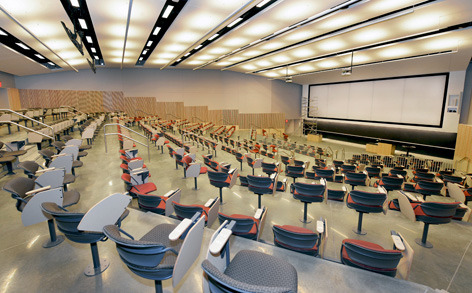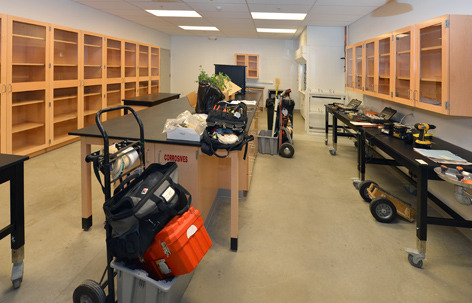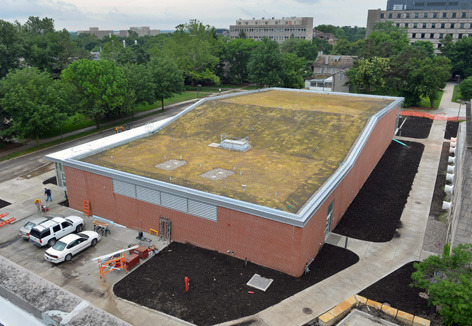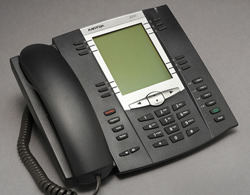Troxel Hall is moving toward opening day

Workers are putting the finishing touches on Troxel Hall, the new state-of-the-art teaching auditorium on the east side of campus. The 400-seat general university classroom is nearly booked for fall semester, including seven sections per day of 100-level chemistry on Mondays, Wednesdays and Fridays (Tuesdays and Thursdays 2:10-5 p.m. is open). Instructor orientation in the auditorium begins Friday; the building officially will be dedicated on Friday, Aug. 30.

The teaching auditorium includes a preparatory lab (pictured above), an instructor's storage room and an adjoining room for follow-up conversations between instructors and students after class. The building's elevator in the northeast corner services the three seating tiers (of eight total) equipped with accessible seating. Troxel Hall's green roof (pictured below) was planted last month. Photos by Bob Elbert.

Iowa law adds improvement plan requirement to large courses
As instructors put the final touches on their fall syllabi, those who are teaching large courses will be identifying student learning outcomes and integrating continuous improvement plans mandated by Iowa law. The requirement applies to all three state Board of Regents universities.
CELT help
The Center for Excellence in Learning and Teaching can help instructors with assessment strategies and tools, such as online Class Climate course evaluation surveys. Contact CELT for more information.
The legislation (SF2284, HF604) will impact more than 560 courses at Iowa State over the next three years. This fall, courses with an annual enrollment of more than 300 students must implement a continuous improvement plan -- a total of 167 courses at Iowa State. Courses with enrollments of more than 200 and 100 students will be added in the fall of 2014 and 2015, respectively.
Courses that fall under the legislation range from introductory to upper-level classes. They also include some lab sections, orientation seminars and even the marching band (Music 114A). The legislation applies to courses with single or multiple sections. For instance, it includes Chemistry 177 -- with an annual enrollment of about 1,700 total students in six sections of 285; and English 250 -- which has an annual enrollment of about 3,600 total students split into in 150 sections of 24.
Continuous improvement plans at all three regent universities must contain four components, including:
- A focus on student learning outcomes, which are outlined on the course syllabi
- Data collection on the course and learning outcomes
- Implementation of changes based on data
- Continuous feedback and reassessment of data
Staff in the provost's office and members of the Faculty Senate's student outcomes assessment committee are developing a method to collect information about learning outcomes, course assessments and changes/progress made with the continuous improvement plans. The results will be used in the regents' annual progress report to legislators.
Building on what's in place
Karen Zunkel, director for undergraduate programs and academic quality in the provost's office, is helping to coordinate implementation at Iowa State. She said the continuous improvement plans will build on processes that already are in place.
"The implementation plans of all three universities are allowing individual faculty members, departments and colleges to build upon existing efforts as they address this new legislation for continuous improvement plans," Zunkel said. "For example, the mathematics department at Iowa State has been working hard the past several years to improve student performance in some of their entry-level courses. They are monitoring student success data, implementing new course placement systems and course structures, and increasing academic support systems. These efforts align well with the concept of a continuous improvement plan."
Zunkel said the continuous improvement plans must focus on the same requirements, but there is flexibility for implementation. For example, learning outcome assessments may be measured by exam questions, projects or student course evaluations.
"The range of courses and the types of learning outcomes expected in courses covered by this legislation are so diverse that a one-size-fits-all version of a continuous improvement plan is not feasible or appropriate," Zunkel said. "The faculty members and departments teaching the courses are in the best position to determine what makes sense as far as the data and assessments to be used for their courses."
New revenue in FY14 budget will target priority items
Iowa State's proposed general operating fund budget for the year that begins July 1 includes approximately $32.2 million in additional revenue above the current budget. Most of the new dollars will be invested in salary and benefits increases, new faculty hires, student financial aid and initiatives that support four broad priorities shared last fall by President Steven Leath:
• Maintain academic excellence
• Enhance the university's basic and applied research footprint
• Promote economic development
• Improve the campus environment
The new revenue includes nearly $6.8 million in additional operating dollars from the state and about $2.4 million in interest and fee income. Much of it – about $26.9 million – is in tuition revenue due to both anticipated higher enrollment and tuition increases for resident graduate students (1.2 percent), nonresident students (2.35 percent) and veterinary medicine students (3.5 percent). Tuition will be held flat for in-state undergraduates in 2013-14, as will mandatory fees for all students.
But the net new income also reflects expected decreases in federal appropriations to ISU Extension and Outreach and the Experiment Station (-$0.76 million) and in indirect cost recovery on federal government-sponsored research (-$3.1 million), both due to the sequestration that began March 1.
University leaders will ask the state Board of Regents to approve the FY14 budget when the board meets Aug. 8 in Ames.
"We're grateful for the 2.6 percent HEPI (Higher Education Price Index) operating increase we requested from the Legislature," Leath said. "We take this as a sign that the Legislature and governor see Iowa State as a smart investment in the future of our state."
FY14 new revenue: How it will be used
| Nondiscretionary (subtotal) | $6.76 million |
| New buildings (Troxel, small animal hospital) | $1.00 million |
| Employee insurance plans (3) | $2.49 million |
| Merit employees contract | $0.52 million |
| Inflationary and regulatory increases | $2.75 million |
| Discretionary (subtotal) | $13.94 million |
|
Performance-based salary increases: faculty, P&S, postdocs |
$7.26 million |
| Student financial aid | $5.68 million |
| Deferred maintenance | $1.00 million |
| Priority funds (use set by senior VPs) | $11.51 million |
| Academic affairs | $10.25 million |
| Student affairs | $403,000 |
| Business and finance | $685,000 |
| Central administration | $173,000 |
| TOTAL | $32.21 million |
Priority funds
Nearly one-third of the incremental revenue ($10.3 million) will be used for employee salary and health insurance increases. The decisions and inflationary costs guiding these increases were summarized in a June 6 Inside story.
Another third of the new revenue will support the university-wide priorities Leath announced last fall. He pledged that they would influence operating budgets, building projects and hiring decisions during the next few years.
Each of Iowa State's three major divisions (academic affairs, student affairs, business and finance) received funds for FY14 to support these priorities. Earlier this month, the senior vice presidents submitted proposals to Leath on how they would use their allotted funds, along with any reallocated dollars they chose to put toward priority initiatives. Some of those approved uses follow.
- Student affairs: Staff positions for the Writing and Media Help Center, disability services, international student advising and admissions counseling, as well as additional support for prospective student campus visits and supplemental instruction services.
- Business and finance: Additional support for emergency management and preparedness services and for human resources data needs, new positions and supplies in facilities planning and management, additional officers and a dispatch position in public safety, and an additional accountant in the payroll office.
- Academic affairs: Additional faculty positions for high-demand courses, new Presidential Graduate Scholars program (recruit top students and grow Ph.D. enrollment), new academic advising positions in Human Sciences and Liberal Arts and Sciences colleges, support for 4-H youth programs, funds for organizational development in extension and outreach, additional class sections for an MIS core class in the Business college, distance education additions in Agriculture and Life Sciences, instructional technology and lab safety improvements in the Engineering college, library acquisitions, technology upgrades in general university classrooms, additional funds for the high performance computer initiative, funds for multi-year efforts to expand college research portfolios.
"These investments are critical to ensuring that Iowa State continues to provide excellence in academics, research and economic development, but also continues to provide students with the valuable experiences and opportunities they expect," Leath said.
One-time state funds
Iowa State also will receive one-time state funding in FY14 for these initiatives and building projects:
| Bioeconomy Initiative | $7.50 million |
| Biorenewables Research Lab Phase 2* | $21.75 million |
|
Economic development building at the ISU Research Park |
$12.00 million |
|
Veterinary medicine building at Blank Park Zoo (renovation) |
$1.00 million |
| Deferred maintenance | Undetermined portion of $2.00 million |
* New teaching, research and administrative space for the agricultural and biosystems engineering department, FY14 funding is the third of a 4-year, $60.4 million state commitment
"We are very grateful for the support that was provided for the Bioeconomy Initiative and research park -- this funding will help us to better promote economic development and job growth," Leath said. "However, I am disappointed that funding for the planning of the biosciences building – the university's top priority for capital funding – will not be provided in FY14. We intend to work with the Legislature and the governor again next year to try and gain support for this critical project."
No tuition set aside
Adhering to new legislation approved in the statehouse this spring, Iowa State will not use any tuition dollars from in-state undergraduate students for financial aid. The so-called "tuition set-aside" practice at the three regents universities, which dated back to the 1960s, most recently placed a minimum of 15 percent of tuition dollars into a student financial aid pool. Iowa State's actual practice had been to set aside about 22 percent of tuition dollars.
The 2013 Legislature did not fund a requested $39.5 million student aid program to help meet the financial need of resident undergraduates at the three schools. All university-based resident undergraduate financial aid will be funded from operating appropriations to Iowa State.
The new legislation allows the regent universities to continue to designate tuition revenue from nonresident students for financial aid.
The university's proposed general operating fund budget for the year that begins July 1 is $607.7 million, approximately a 5 percent increase over the current year. Iowa State's proposed total budget is just over $1.2 billion, which includes sponsored research and auxiliary units such as athletics, utilities, bookstore, residence and dining.
State appropriation will help expand research park
An appropriations bill signed June 20 by Gov. Terry Branstad will help expand the Iowa State University Research Park and improve service to new and growing companies.
The bill includes $12 million to finance construction of a new building to house services and agencies that assist Iowa businesses. The research park is located south of the Iowa State campus, adjacent to Highway 30.
“Iowa State is grateful to the Iowa Legislature and Gov. Branstad for providing the resources to make this expansion possible. This is a significant investment for the park and for economic development in Iowa,” said President Steven Leath. “This action by our elected leaders demonstrates their confidence in the role and reputation of the ISU Research Park.”
Bringing together services, agencies
The new facility will house services and agencies that currently are scattered across the Iowa State campus. These include the Small Business Development Center, the Pappajohn Center for Entrepreneurship, the Office of Intellectual Property and Technology Transfer and the Iowa State University Research Foundation, among others.
“The research park is gratified by the support this investment represents. Iowa State University and the State of Iowa have been key partners in creating the success we have achieved to date. The support of President Leath, Gov. Branstad and the Iowa Legislature will accelerate our plans for growth of the park,” said Steven Carter, president of the research park.
Construction of the new building is expected to be completed within the next three years.
“This is tremendous news for Ames and Central Iowa,” said Dan Culhane, president and CEO of the Ames Chamber of Commerce. “The ISU Research Park has proven to be a vibrant economic engine that continues to provide significant return on investment.”
Jay Byers, CEO of the Greater Des Moines Partnership, said the research park and Iowa State are key partners in development of the Capital Corridor (Ames-Des Moines).“The research park is a tremendous economic development asset that spurs innovation and generates jobs for the region, and this new strategic state investment is a huge win for the research park and the corridor.”
Expansion necessary
Leath said as a result of the growth and innovation by companies in the research park, the park is approaching capacity, and expansion is necessary.
“I indicated last year that one of my priorities is to double the size of the research park,” Leath said,” and I’m confident this new facility will help achieve that goal.”
The research park includes companies of varying sizes, and provides critical support services to help the resident companies succeed. The 230-acre park currently has 57 tenants with 1,200 employees and annual payroll exceeding $60 million.
On the phone: Nice web portal tricks
Editor's note: Iowa State University no longer uses Aastra telephone products. Information about current phone hardware is in IT portal's voice and conferencing services.
Your web-based phone portal gives you access to many advanced features on your new Aastra phone. You can send an audio copy of your voice mail to email. You can see if your often-called colleagues are on the phone. And if your phone isn't displaying your name correctly, you can fix it.
This week's tips
- Send audio copy of voice mail to email
- See the status (busy or idle) for selected phone extensions
- Forward calls to another number
- Change your name display
Aastra 6737i or Aastra 6739i
Many of the phone features you'll see in the portal haven't been activated yet, because phone techs are putting their energies into phone installation. However, these features will be steadily added to your phone options in the coming months.
Set up your portal
You'll need to set up your phone portal before accessing its features. Here's how:
- Find the default password provided by your voice/data coordinator when you received your new phone
- Go to: phone.iastate.edu
- Enter your user ID, which starts with your 10-digit ISU phone number and ends with "@voice.iastate.edu." Your user name will look something like this: 515294XXXX@voice.iastate.edu
- Enter the default password
- Change the default password to your personal password. Your password must have 6-60 characters including one number, one uppercase letter, 1 lowercase letter and one non-alphanumeric symbol. You can't use your login ID, a previous password or a previous password in reverse
- Your portal is ready for action when you see the profile page
Login troubleshooting
Occasionally, you may get a "Clearspan server unavailable" message when trying to log in to the portal. Despite the message, it's quite likely that the server is available, but that lengthy user ID or password is incorrect. Try again and if you're on your fifth try, take extra care. Five incorrect attempts locks you out, at which point you'll need to call the Solution Center, 4-4000, for a password change.
Summer projects will close roads, sidewalks
As certain as flip flops and iced coffee, summer also means a few road construction projects around campus. Here are details on three significant ones that may impact your commute to campus.
West side of campus: West end of Osborn Drive
Plans to improve electrical service to the northwest part of campus will set up construction zones along the east side of Bissell Road during the next 45 days.
Where is that?
This campus map (PDF) provides a visual of when and where lane or road closures will occur this summer (scroll down to see the South 16th Street project).
The west end of Osborn Drive is scheduled to be closed for 14 days after the July Fourth holiday weekend. Pammel Drive at Bissell Road will remain open when the work moves there near the end of July, but lane closures will create a single lane of traffic in each direction.
During the project, pedestrians should expect temporary sidewalk closures at these locations:
- From the front (west) doors of Sweeney Hall north to Osborn Drive
- From the north side of the Armory east to Hach Hall
Drivers can expect temporary lane or driveway closures at these locations:
- Coover/Sweeney driveway
- Osborn Drive
- Pammel Drive
- Armory west parking lot
- Armory north parking lot
East side of campus: University Boulevard between Lincoln Way and Stange Road
Concrete patching work on University Boulevard between Lincoln Way and Stange Road is scheduled to begin July 15 and be completed in two phases. Phase 1 includes work between Lincoln Way and Sixth Street. To shorten the duration and maximize the construction quality of Phase 1, this section of University Boulevard will be closed for an anticipated 10-14 days. Alternate routes onto campus will include Beach Road, N. Hazel Road to Sixth Street, or Grand Avenue to Sixth or 13th streets. Phase 2 construction (Sixth Street to just west of Stange Road) will require lane closures in late July/early August with a single lane of traffic in each direction.
Veterinary Medicine campus: South 16th Street/Christensen Drive/South Riverside Drive
This project features several improvements to improve traffic flow through the South 16th Street corridor, including:
- Widen the approaches on South Riverside Drive (Vet Med entrance A) at South 16th Street
- Construct a right turn lane on Christensen Drive (Vet Med entrance B) at South 16th Street
- Lengthen the right turn lane on South 16th Street at University Boulevard
The work is scheduled to begin in early July and last approximately three weeks. Work on Christensen and Riverside drives will require road closures, so a temporary drive will be constructed across the grass lot between the two roads to provide access to the Veterinary Medicine campus. Lane closures will be necessary to complete the right turn lane extension at University Boulevard.
Aastra 6739i: Voice to email, call forwards, busy alerts

Aastra 6739i (PDF user guide)
Send voicemail to email
You can automatically send audio copies of your voice mails to email with a tweak in your portal account.
- If you haven't done so, set up your portal
- Sign in at the portal site, phone.iastate.edu
- In left navigation, click "messaging"
- Click "voice management"
- Under the "additionally" section, check "email a carbon copy of the message to" and insert your email address in the blank
- Caution: Don't use the "when a message arrives" section to forward your voice mail unless you want all voice messages to completely bypass your voice mail box and go only to email
- Press "apply" or "OK" button
Access voice mail from an off-campus phone
- Dial (515) 296-6245. You'll need your mailbox ID, which is your 5-digit extension (for example, 4-XXXX), and your passcode
Monitor certain phone extensions to see if they're busy
The busy lamp field (BLF), allows you to see at a glance whether certain extensions are busy or idle. The LED lights up when an extension is in use.
- If you haven't done so, set up your portal
- Go to phone.iastate.edu and sign in
- Click "client applications" in the left navigation
- Click "busy lamp field"
- Use the search criteria to find and add names to your BLF list
- You can rearrange the list order by highlighting an entry and using the "move up" or "move down" buttons
- Click "apply" or "OK" button
To monitor BLF extensions:
- Your phone screen may not display last names of those on your BLF list, but their extensions will appear in the softkeys on the screen
- You'll see a few extensions at a time. Click the "more" softkey (bottom right with two small dots) to toggle to other listings
- When one of your monitored extensions is busy, the corresponding softkey is red and its icon displays an off-hook receiver
- If the LED is flashing, the user is receiving an incoming call
To speed dial one of your BLF numbers:
- Press the BLF softkey adjacent to that number
Forward incoming calls to another number
When you're on your phone or not answering, incoming calls usually are directed to voicemail. Call forward allows you to bypass voice mail and direct those calls to another number. You have three forwarding options:
- "All" or "always" forwards all incoming calls
- "Busy" forwards incoming calls when you're on the phone
- "No answer" forwards calls not answered in a specified number of rings
While you can set call forward from the portal or phone (both instructions follow), the portal option currently works best, especially when setting the "busy" or "no answer" modes.
Call forward (from the portal)
- If you haven't done so, set up your portal
- Go to phone.iastate.edu and sign in
- Click "incoming calls" in the left navigation
- Click on one of the three call forwarding options
- Fill in the forwarding number (10 digits, no hyphens), for example, 515294XXXX, and click the "on" button
- Click "apply" or "OK " button
Call forward (from the phone)
- Press the "call forward" softkey
- Press "on" for any or all of the three forwarding options ("all," "busy," or "no answer") and fill in forwarding number
Change the name on your phone display
- If you haven't done so, set up your portal
- Go to phone.iastate.edu and sign in
- Under "basic" in the main section, click "profile"
- Make name corrections
- Click "apply" or "OK" button
Aastra 6737i: Voice to email, call forwards, busy alerts

Aastra 6737i (PDF user guide)
Send voicemail to email
You can automatically send audio copies of your voice mails to email with a tweak in your portal account.
- If you haven't done so, set up your portal
- Sign in at the portal site, phone.iastate.edu
- In left navigation, click "messaging"
- Click "voice management"
- Under the "additionally" section, check "email a carbon copy of the message to" and insert your email address in the blank
- Caution: Don't use the "when a message arrives" section to forward your voice mail unless you want all voice messages to completely bypass your voice mail box and go only to email
- Press "apply" or "OK" button
Access voice mail from an off-campus phone
- Dial (515) 296-6245. You'll need your mailbox ID, which is your 5-digit extension (for example, 4-XXXX), and your passcode
Monitor certain phone extensions to see if they're busy
The busy lamp field (BLF) allows you to see when certain extensions are busy or idle. The LED lights up when an extension is in use.
- If you haven't done so, set up your portal
- Go to phone.iastate.edu and sign in
- Click "client applications" in the left navigation
- Click "busy lamp field"
- Use the search criteria to find and add names to your BLF list
- You can rearrange the list order by highlighting an entry and using the "move up" or "move down" buttons
- Click "apply" or "OK" button
To monitor BLF extensions:
- Your phone screen may not yet display last names of those on your BLF list, but their extensions will appear in the softkeys on the screen
- You'll see a few extensions at a time. Click the "more" softkey to view others
- When one of your monitored extensions is busy, the corresponding LED lights up and the phone icon displays an off-hook receiver
- If the LED is flashing, the user is receiving an incoming call
To speed dial one of your BLF numbers:
- Press the BLF softkey adjacent to that number
Forward incoming calls to another number
When you're on your phone or not answering, incoming calls usually are directed to voicemail. Call forward allows you to bypass voice mail and direct those calls to another number. You have three forwarding options:
- "All" or "always" forwards all incoming calls
- "Busy" forwards incoming calls when you're on the phone
- "No answer" forwards calls not answered in a specified number of rings
While you can set call forward from the portal or phone (both instructions follow), the portal option currently works best, especially when setting the "busy" or "no answer" modes.
Call forward (from the portal)
- If you haven't done so, set up your portal
- Go to phone.iastate.edu and sign in
- Click "incoming calls" in the left navigation
- Click on one of the three call forwarding options
- Fill in the forwarding number (10 digits, no hyphens), for example, 515294XXXX, and click the "on" button
- Click "apply" or "OK " button
Call forward (from the phone)
- Press "options" key
- Press â–¶ to select "call forward"
- Scroll to the desired mode ("all," "busy," or "no answer") and select
- Fill in the forwarding number and turn "state" on by toggling â–¶ or the "change" softkey
- Back out by hitting "done" softkey three times
Change the name on your phone display
- If you haven't done so, set up your portal
- Go to phone.iastate.edu and sign in
- Under "basic" in the main section, click "profile"
- Make name corrections
- Click "apply" or "OK" button
Students, alumni to exhibit work at Des Moines Arts Festival
Nine College of Design students or recent graduates are among 20 Emerging Iowa Artists who will exhibit their work at the Des Moines Arts Festival, June 28-30 in the downtown Western Gateway Park.
Now in its 11th year, the Emerging Iowa Artists program provides an opportunity for young visual artists to showcase their talents at one of the nation’s top arts festivals, which attracts more than 200,000 visitors.
Students from Iowa State this year are Amber Forbes, Underwood, senior in integrated studio arts; and integrated visual arts graduate students Amanda Hall, Ames, and Sodam Lee, Chunansi, South Korea.
Recent graduates include:
- Clark Colby III, Urbandale, Bachelor of Architecture, 2011
- Dillon Baker, Des Moines, Bachelor of of Fine Arts in integrated studio arts, 2012
- Kristen Greteman, Des Moines, Bachelor of Architecture, 2011
- Desiree Becker, Ames, Bachelor of Fine Arts in integrated studio arts, 2012
- Peter Kasper, Tiffin, Bachelor of Fine Arts in integrated studio arts, 2012
- Arty Vongphakdy, Sioux City, Bachelor of Fine Arts in integrated studio arts, 2012
Two other ISU alumni -- Carrie Hoffnagle, Minneapolis (2006, integrated studio arts and journalism/mass communication), and Chris Vance, Bondurant (2000, visual studies) -- are among the 185 professional artists chosen to participate in the Des Moines Arts Festival this summer.
Admission to the arts festival is free. Festival hours are:
- Friday, June 28: 11 a.m.-10 p.m.
- Saturday, June 29: 10 a.m.-10 p.m.
- Sunday, June 30: 10 a.m.-5 p.m.
